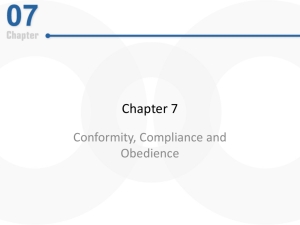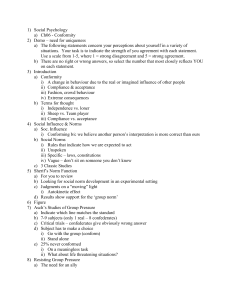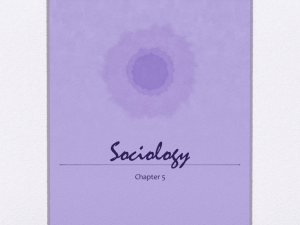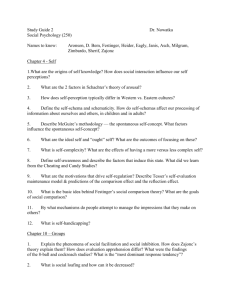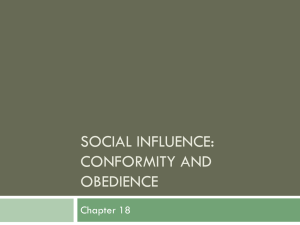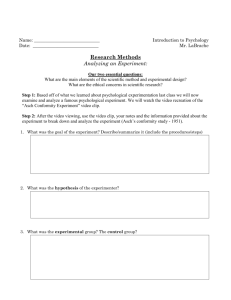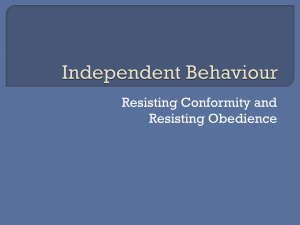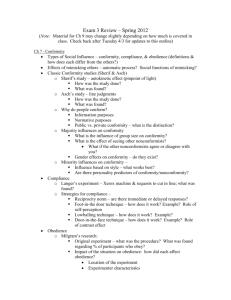Ch 7 PP
advertisement
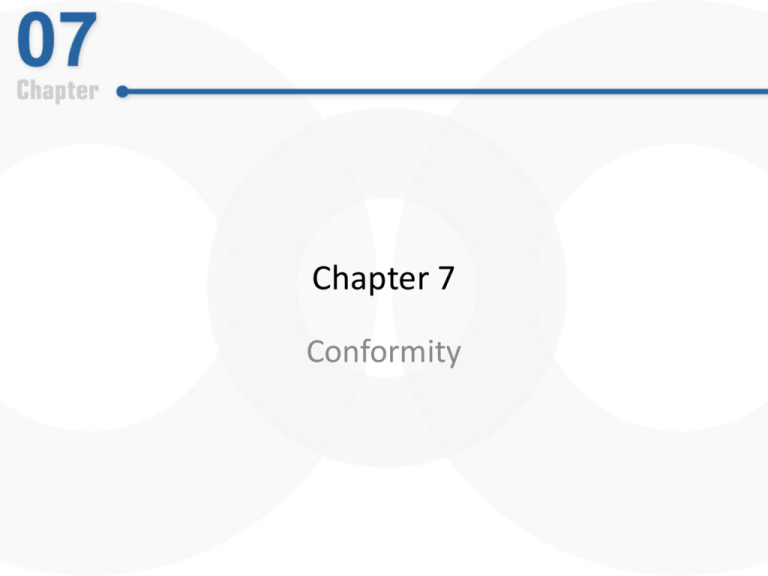
Chapter 7 Conformity Social Influence as “Automatic” • Do humans imitate one another automatically, without thought, effort, or conflict? Conformity • Tendency to change perceptions, opinions, or behavior in ways that are consistent with group norms. The Early Classics • Sherif’s study (1936) • Asch’s study (1951) What Did Asch’s Participants Do? • Participants went along with the clearly incorrect majority 37% of the time. • However, 25% of the participants NEVER conformed. • Still, 50% conformed for at least half of the critical presentations. – The rest conformed on an occasional basis. Why Do People Conform? • Informational Influence: People conform because they believe others are correct in their judgments. • Normative Influence: People conform because they fear the consequences of appearing deviant. Types of Conformity • Private Conformity: Changes in both overt behavior and beliefs. • Public Conformity: Superficial change in overt behavior only. Majority Influence: Group Size • Conformity increases with group size -- but only up to a point. • Why? – Law of “diminishing returns”? – Perception that others are either in “collusion” or “spineless sheep”? Majority Influence: Having an Ally in Dissent • When there was an ally in Asch’s study, conformity dropped by almost 80%. • Why does having an ally reduce majority influence on our behavior? – Substantially more difficult to stand alone for one’s convictions than when one is part of even a tiny minority. – Any dissent can reduce the normative pressures to conform. Minority Influence: The Power of Style • Moscovici: Nonconformists derive power from the style of their behavior. – “Consistent dissent” approach • Hollander: Minorities influence by first accumulating idiosyncrasy credits. – “First conform, then dissent” strategy Processes and Outcomes of Minority Influence • Does minority influence work just like the process of conformity? • Do majorities and minorities exert influence in different ways? – Because of their power and control, majorities elicit public conformity through normative pressures. – Because seen as seriously committed to their views, minorities produce private conformity, or conversion. Culture and Conformity • Cultures differ in the extent to which people adhere to social norms. • What determines whether a culture becomes individualistic or collectivistic? – The complexity of the society – The affluence of the society – The heterogeneity of the society Compliance • Changes in behavior that are elicited by direct requests. Mindlessness and Compliance • Talking fast and catching people off guard can improve compliance rates. • People can be disarmed by the simple phrasing of the request. – How you ask for something can be more important than what you ask for. – Langer: We often respond mindlessly to words without fully processing the information they are supposed to convey. Mindlessness and Compliance (cont’d) • Mindlessness can make us more vulnerable to compliance, but can also have opposite effect Norm of Reciprocity • The powerful norm of reciprocity dictates that we treat others as they have treated us. – This norm leads us to feel obligated to repay for acts of kindness, even when unsolicited. • Norm of reciprocity is relatively short-lived. Sequential Request Strategies: Foot-in-the-Door Technique • Person begins with a very small request; secures agreement; then makes a separate larger request. • Why is it effective? – Self-perception theory revisited Sequential Request Strategies: Low-Balling • Person secures agreement with a request and then increases the size of that request by revealing hidden costs. • Why is it effective? – Psychology of commitment Sequential Request Strategies: Door-in-the-Face Technique • Person begins with a very large request that will be rejected; then follows that up with a more moderate request. Sequential Request Strategies: That’s Not All, Folks! • Person begins with a somewhat inflated request; then immediately decreases the apparent size of the request by offering a discount or bonus. Sequential Request Strategies Assertiveness: When People Say No • To be able to resist the trap of compliance techniques, one must: – Be vigilant – Not feel indebted by the norm of reciprocity • Compliance techniques work smoothly only if they are hidden from view. Obedience • Behavior change produced by the commands of authority Milgram’s Research: Forces of Destructive Obedience • Conducted his experiments during the time that Adolph Eichmann was being tried for Nazi war crimes. • His unorthodox methods have been the subject of much ethical debate. The Learner’s Protests in the Milgram Experiment The Learner’s Protests in the Milgram Experiment The Obedient Participant • Milgram’s participants were tormented by experience. • No gender differences observed in level of obedience. • Milgram’s basic findings have been replicated in several different countries and among different age groups. Factors that Influence Obedience Important Factors That Influence Obedience • Physical presence and apparent legitimacy of the authority figure • The victim’s proximity • The experimental procedure – Participants were led to feel relieved of personal responsibility for the victim’s welfare. – Gradual escalation was used. Defiance: When People Rebel • Social influence can also breed rebellion and defiance. • Having allies gives individuals the courage to disobey. The Continuum of Social Influence Social Impact Theory • Social influence depends on three factors: – The strength of the source – The immediacy of the source to the target in time and space – The number of sources Social Impact: Source and Target Factors Perspectives on Human Nature • Are people generally malleable or unyielding? • Cultural differences – Some cultures value autonomy and independence whereas others place more emphasis on conformity to one’s group. – Within a given culture, these values can change over time.
